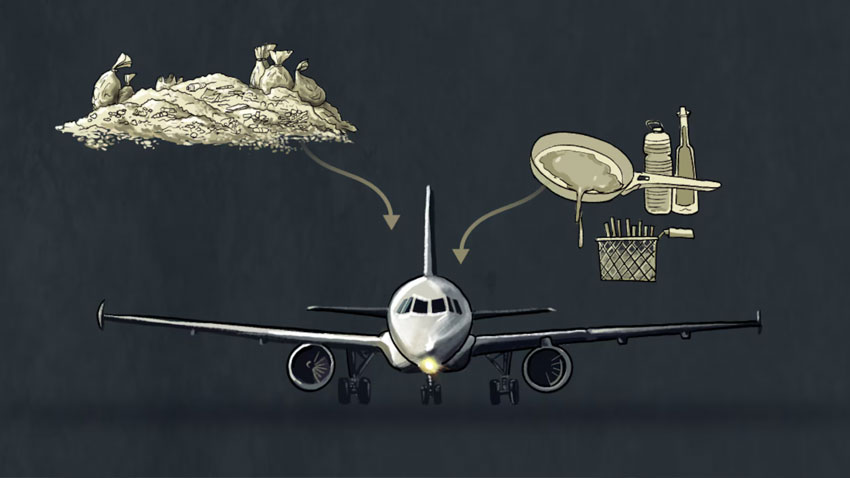
Boston-based World Energy was one of the first companies in the world to produce commercial quantities of sustainable aviation fuel (SAF), a type of renewable fuel made from sources such as used cooking oil, agricultural residues and other waste.
Its Paramount refinery near downtown Los Angeles had been a rare success story, supplying millions of gallons of SAF a year to airlines such as United Airlines and fellow U.S. carrier JetBlue Airways. The plant, which began operations in 2016, was central to the carriers’ pledges to help the airline industry switch to a blend of 10% SAF by the end of this decade.
But the refinery quietly ceased operations in April. And World Energy’s plans for a second plant in Houston have stalled amid a lack of commitment from the industry, according to Chief Executive Gene Gebolys.
“Some airlines were engaged in a pretty disingenuous effort to put out press releases” overstating their commitment to SAF projects, Gebolys said, without naming any companies. “People sometimes said too much in the past and did too little.”
Still, Gebolys acknowledged that some airlines have made a genuine effort to support SAF producers, while governments also needed to step up with stronger incentives to drive progress.
The termination of United’s fuel purchase contract with World Energy - and the closure of the Paramount refinery - have not previously been reported.
United Airlines said it ended its relationship with World Energy “a few years ago”, without providing a reason. A JetBlue spokesperson said World Energy has been a “valued partner” since 2020 and it will continue working with the company.
World Energy’s struggles mirror the plight of dozens of clean fuel startups, according to a Reuters review of the sector. Nearly 20 years after the first commercial flight powered partly by biofuels made the short hop from London to Amsterdam, Reuters found that the airline industry’s plans to go green before regulators start penalising them are little more than a pipe dream.
Read more: As Gaza faces starvation, reluctant Germany starts to curb support for Israel
No clear pathway
The International Air Transport Association (IATA), a global body that represents 340 airlines, forecasts SAF will account for 0.7% of total jet fuel this year, up from 0.3% in 2024. Air passenger traffic, meanwhile, is expected to rise 6% this year, IATA says.
IATA has set a goal of net zero emissions by 2050, a target that would require airlines to ramp up SAF use to 118 billion gallons annually, a more than 300-fold increase from current production.
Airline industry leaders point to a wave of new SAF initiatives they say will spark a boom similar to the rapid rise of electric vehicles and solar energy.
However, the aviation sector has yet to publish a comprehensive roadmap or a transparent database of upcoming SAF projects that would allow regulators and the public to assess the credibility of these projections.
To scrutinise the industry’s claims, Reuters built its own database of airline SAF initiatives - offering the most comprehensive view yet of the sector’s faltering green progress and revealing that the industry has no clear pathway to hitting net zero targets.
While airlines have announced 165 SAF projects over the past 12 years, only 36 have materialized, Reuters found. Among those, Reuters uncovered problems at three of the largest - including World Energy - that exemplify the systemic challenges plaguing the SAF sector.
These circles represent the 165 SAF projects announced by airlines over the past 12 years.
Reuters was unable to find any public updates on the progress of 44 of these projects since their initial announcements.
Of the remaining 73%, four were deals for SAF credits where no physical fuel is delivered and 23 have been abandoned.
Out of the 94 left, 27 are delayed or on indefinite hold and 31 have yet to produce any fuel. Only 36 have materialised, Reuters found.
Among those 36, only 10 projects - just 6% of the total - have reported producing commercial volumes of SAF.
If all the pending projects announced by airlines reached their maximum potential, it would only add 12 billion gallons of SAF production, the Reuters analysis found. That’s about 10% of what’s needed to hit the net zero target.
Airlines pin the problems on the oil industry, saying it isn’t producing enough fuel.
“These guys are the cause of the problem, and they’ve got to start playing their part,” said Willie Walsh, director of IATA, the global airline lobby, and a former chief executive of British Airways and its parent International Airlines Group.
At the moment, SAF costs three to five times more than jet fuel and some oil company executives argue that there is limited demand from airlines at current prices.
“I’d like there to be a shortage. I actually see an overcapacity,” Bernard Pinatel, the head of downstream and marketing and services at TotalEnergies, told a press briefing in June.
Paramount ‘reset’
The Paramount refinery, which used cooking oil and animal fat from a local abattoir to make fuel, repeatedly stumbled in its efforts to expand and all 35 employees were laid off in April, two sources with direct knowledge of the matter said.
The future of the plant is uncertain, the two people said, after World Energy’s partner, Air Products, withdrew from the project in February, citing challenging commercial conditions tied to the expansion and operations. Air Products, a U.S. industrial gases and chemicals company, had been slated to lead a $2 billion expansion of the site.
World Energy CEO Gebolys said Paramount’s closure was a “reset” because the refurbishment was over budget and behind schedule. He said it would come back online, without giving a time frame. He declined to comment about the layoffs.
According to more than a dozen people directly involved in the sector, airlines play minimal roles in the execution of projects and, in most cases, their only commitment is to buy SAF when their partners produce it.
What’s more, airlines are making bold projections about SAF use and emissions reductions based on unproven technologies or early-stage projects run by startups with no experience of commercial production, Reuters found.
Of the 36 projects that have produced any SAF, all but one rely on the Hydroprocessed Esters and Fatty Acids (HEFA) process to convert waste oils, fats and grease into jet fuel. HEFA was the technology used at Paramount.
However, HEFA plants are severely constrained by the limited availability of suitable raw materials and cannot meet the industry’s long-term fuel demands, three industry specialists said.
IATA chief economist and sustainability executive Marie Owens Thomsen disputed the idea airlines only play a minimal role, saying they were striking SAF purchase agreements and investing in new technologies, supporting early-stage innovation and collaborating with research institutions.
She also said alternative ways of making SAF needed to be developed alongside HEFA, as this process alone would not be sufficient to produce enough fuel to hit net zero by 2050.
The most common way to make sustainable jet fuel
The Hydroprocessed Esters and Fatty Acids (HEFA) process transforms fats and oils into SAF, but limited feedstock availability constrains mass production.
1. Waste oils and fats
Waste oils, animal fats and non-edible oil crops are collected and sorted.
There is a limited supply of oils and fats, which must be collected from diverse sources, driving up costs.
2. Pretreatment
Impurities are removed from the feedstock oil before refining.
Cleaning is energy intensive and adds significant processing costs, but is necessary for later steps to work.
3. Hydrogenation
The oil undergoes a chemical reaction to convert the fatty acids into hydrocarbons.
The reaction is technically demanding and capital intensive. It requires large volumes of high-purity hydrogen, which is often produced from fossil fuels.
4. Hydrodeoxygenation
Oxygen is removed from the molecules in the form of water. This further purifies the fuel and reduces the oxygen content.
5. Hydrocracker
The larger hydrocarbons are chemically broken into smaller molecules which make up higher quality fuels.
Many SAF producers ship the fuel elsewhere for the final refining steps, adding complexity.
6. Distillation
The distillation column separates the hydrocarbons based on their boiling points. This means that different hydrocarbon chains, with varying carbon lengths, will be separated.
7. Mixing Traditional Fuel
The resulting synthetic fuel is blended with traditional jet fuel.
A diagram showing the steps of Hydroprocessed Esters and Fatty Acids (HEFA) process, which transforms fats and oils into sustainable aviation fuel (SAF), starting from waste oil and fat collection, impurities removal, Hydrogenation (oil undergoes a chemical reaction to convert the fatty acids into hydrocarbons), Hydrodeoxygenation (oxygen removal to purifies the fuel and reduces the oxygen content), Hydrocracker (larger hydrocarbons are chemically broken into smaller molecules), Distillation (The distillation column separates the hydrocarbons based on their boiling points), and the last step when the resulting synthetic fuel is blended with traditional jet fuel to become SAF.
Panama’s energy secretary did not respond to a request for comment.
After the plant opens, the company may switch to making renewable diesel for trucks and ships, because those industries showed more enthusiasm than aviation, Letang said.
“We’re only going to take it so far with SAF until we determine whether or not the airlines are actually serious about making the commitments for this fuel,” he said.
Letang said airlines were competing to announce their own marquee projects, when producers actually needed consortiums made up of many carriers to invest in large-scale projects.
“That’s how you build this industry. Without that, it’s an exercise in futility, quite frankly,” he said. “The airlines could do a lot more.”



